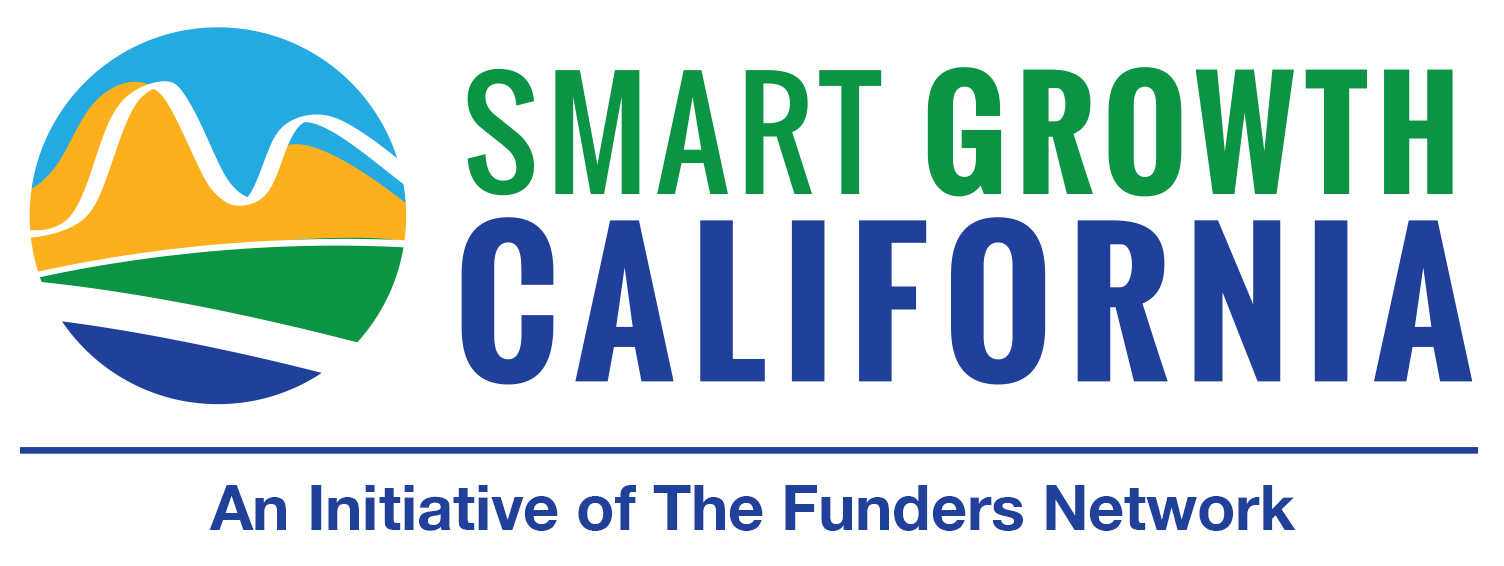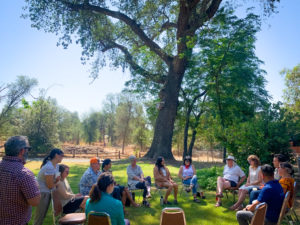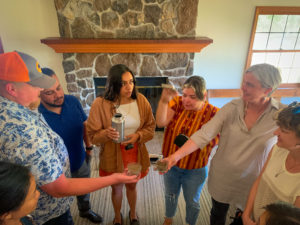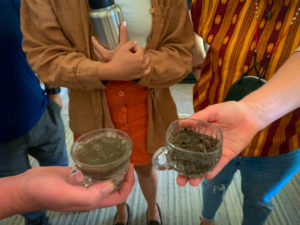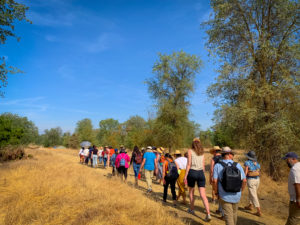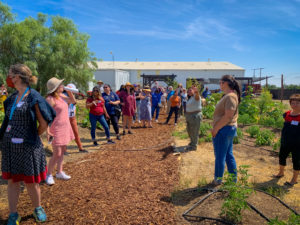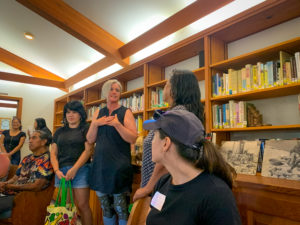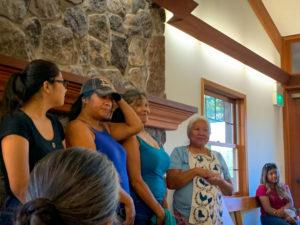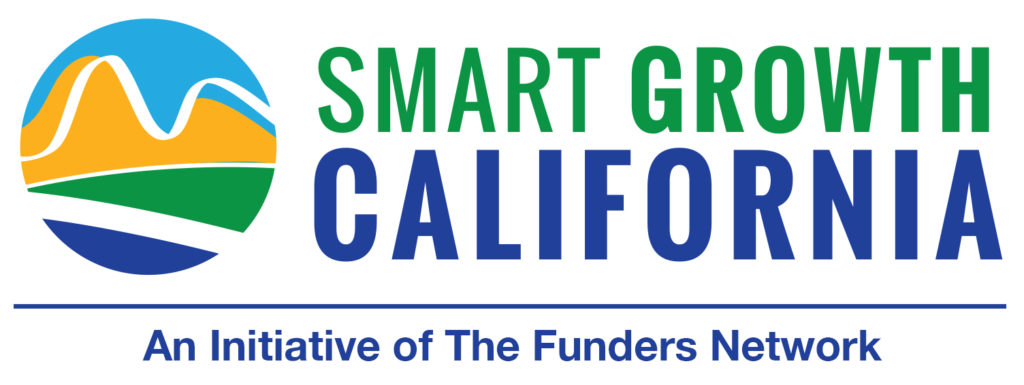Gathering together with the San Joaquin Valley Funders Collaborative on May 25-26 in Tulare County was all I could have asked for and more. I have had the honor of coordinating the SJVFC for over four years now and see this group grow into a trust-based, equity-centered, action-committed group of funders.
The event was originally planned for April 2020 and was canceled due to the pandemic. Back then, we envisioned it as a time to be on the land together and learn from rural communities. We wanted to use it as an opportunity to invite new funders who were growing their interest and investment in the region to meaningfully connect to field leaders and other funders. All of those goals still rang true over two years later, but there was a different context after the pandemic. Field leaders had lost one of their patron leaders, Isabel Arrollo, whose vision guided much of the work in the region. The pandemic forced the local tribe, the Wukchumni, to honestly assess their ability to withstand these kinds of economic and health shocks, and they began to farm their land and teach young people to be more self-sufficient. Philanthropy shifted gears and began to live more fully up to the vision of meeting the needs of groups on the ground with flexible funding during the pandemic. There were new challenges, and also new capacity and willingness to meet those challenges.
Day 1
We spent the first day of our gathering with field leaders visiting small communities and farms (which started at the Community Water Center office in Visalia, then visited the unincorporated community of Tooleville, and onto FoodLink Tulare and Wukchumni Farms). It was over 105 degrees that day, a reminder of the extreme heat events that climate change brings sooner each year, and the health and safety threats that they create for outdoor workers. We carpooled through dusty roads with row after row of monoculture farming on each side of us, and with dry, brown rolling hills in the background. Much of our day was spent at the base of Rocky Hill, a sacred site to the Wukchumni people — a site which they have to ask permission to use for ceremonies. We learned about the work that Clean Water Advocates have done over the last three years as a part of the Power, Equity and Clean Water Collective to bring clean and affordable water to small unincorporated communities, and from the Central Valley Agroecology Network about their bold vision for a new way of relating to land, food, and one another.
Day 2
The following day, one of our funders led an activity that will stick with me. She filled a glass cup with soil from Wukchumni farms – soil that was well-tended with sustainable practices. The soil was a rich brown, with lots of clumps and a strong earthy smell. In contrast, she had run across the street to land farmed by industrial agriculture and scooped up a cup of soil there, which looked more like dust than soil. It had no scent and no clumps. She poured water over both. Within seconds, the soil from the tribe’s farm soaked up the water, but the industrial soil created a barrier to permeation, and the water just sat on top. Even when we left our meeting several hours later, the water had not fully permeated the “soil.” To think of the water wasted when irrigating this type of soil! Even when the rain comes to this drought-stricken region, it doesn’t have the opportunity to soak in the ground and refill the aquifer. Instead, it runs off, full of pesticides, into local waterways, and the farmers dig deeper and deeper wells to irrigate their lands, causing small local residential wells to run dry. The connection between the work for sustainable and equitable farming with the efforts of the Clean Water Advocates was all too clear.
- Janaki Anagha of 11th Hour Foundation demonstrates the difference in two types of soils.
- Two types of soil with two different outcomes for the people living nearby.
On our second day, hosted at Quaker Oaks Farms, where the Wukchumni Farm is located, we had a powerful time of reconnection and visioning with funders. One of our SGC funders often says that good collaboration is built on trust, and that while we can maintain existing trust in virtual spaces, it is much more difficult to build it. To me, this day together was about building and deepening trust, setting the stage for powerful collaboration in the future. I am grateful to the funders for their vulnerability about their learnings and struggles during the pandemic years, and their vision and commitment to be a responsive, equity-centered, and impact-oriented collective.
Takeaways
I am walking away with so many new and reinforced lessons from our time in the Valley, and here are a few:
- Soil: Healthy soils lead to healthy water/air/food, which leads to healthy people and communities. So much starts with the soil.
- Land ownership: For residents to shift from defensive strategies against harmful policies and players, to truly envisioning a new future, they need to own the land on which they work, live, and grow. And funders can help them get there with flexible capital.
- Ready for big investment: Field leaders in the San Joaquin Valley are ready and capable to make their vision a reality and need meaningful investment to get there. They have been underinvested for a long time and are ready to change the story.
- Strategies that work: Partners utilize a variety of strategies for community transformation, from grassroots organizing for strong local leadership, training for skills-building, basic needs provision, advocacy for top-down accountability from state officials, and community ownership for self-determination and regenerative economies. All of these strategies are necessary and interrelated to create lasting change and should all be supported.
- Commitment: This group of funders is deeply committed to the region and approaches their work with the utmost integrity. They are willing to push themselves and their institutions out of their comfort zones and step into new areas of potential funding to meet the moment, including supporting community ownership.
The stories from the San Joaquin Valley that came out of the pandemic – like in many places – were of both loss and resilience, of both tragedy and perseverance. It feels as though the work of the organizations we met with, and the community leaders we learned from, have taken on even greater urgency in a world with so many fragile systems. This is the work of protecting ongoing access to life’s most basic resource, water; growing one’s own food to get beyond the harmful systems of industrial agriculture and ensure good jobs and healthy sustenance; owning land to empower folks to self-determine their futures.
When I think about Smart Growth California’s work in the place where I grew up, the San Joaquin Valley, I am inspired to broaden what we mean when we talk about “smart growth.” I define smart growth as the intersection of land-use, climate and equity. In urban spaces – and historically for Smart Growth California – that has meant that core smart growth issues are things like equitable, transit-oriented communities with affordable housing, and accessible parks and open spaces.
In rural places, however, things look differently. How we use land in the San Joaquin Valley simply cannot be removed from a conversation about industrial ag, the largest owner of land. Nor can industrial ag be removed from the topics of climate (think, air and water pollution) or equity (farmworker treatment, poisoning, and over-pumping local water sources).
Smart Growth Solutions for Small and Rural Communities
This work can also include housing and transportation, but “smart growth” solutions will look different in smaller cities and rural communities.
- Dig-Once: It may include connecting unincorporated communities to municipal water systems while laying broadband at the same time to bring equitable infrastructure access that has health, economic, and educational implications.
- Community/Farmer-Owned Land: It may mean investing in community-driven efforts to buy large quantities of land and to help farmworkers tend this land which leads to healthier food, better jobs, and cleaner air.
- Creative Transportation Solutions: It may mean creative transportation options, such as the small town of Huron (45 mins outside of Fresno) where residents are the first in a statewide pilot to use zero emissions vehicles to provide transportation for their neighbors since buses don’t come to their community.
Just as in cities, all rural communities are not the same. What may work for rural San Joaquin Valley may be different than what works for rural Tahoe, or Imperial county residents. Ultimately, we are reminded that residents know best what their community needs, and philanthropy must entrust their leadership in what smart growth looks like for them.
If you want to deepen your own thinking about these topics in the Valley and work with other funders to actualize a shared vision, feel free to reach out to me about joining the San Joaquin Valley Funders’ Collaborative. It is an amazing group of dedicated funders looking to grow funding and increase impact in this beautiful part of the state.
Sincere Gratitude
Thank you to all the community organizations and their staff and leaders who helped shape our learning exchange: Central California Environmental Justice Network; Community Alliance for Agroecology; Community Water Center; FoodLink Tulare County; Leadership Council for Justice and Accountability; Self-Help Enterprises; and the Wukchumni Tribe. We also recognize and appreciate the participation of many of the funders active in the California Foodshed Funders and look forward to continued collaboration with their network.
no images were found
